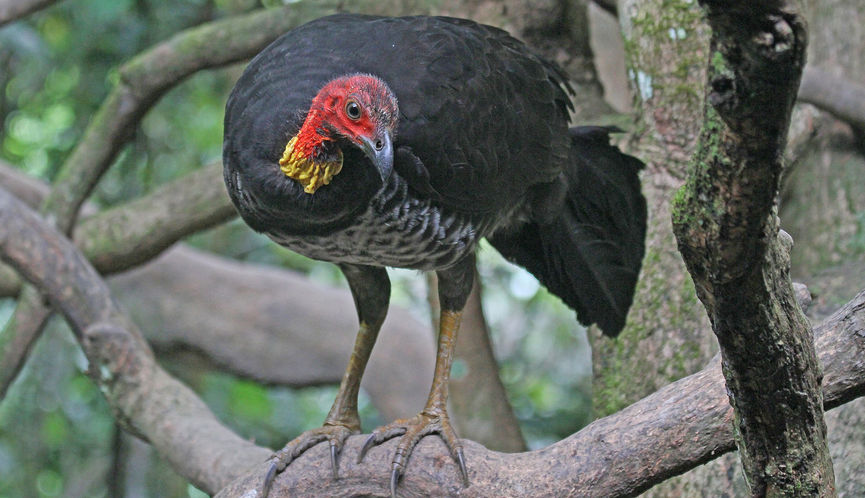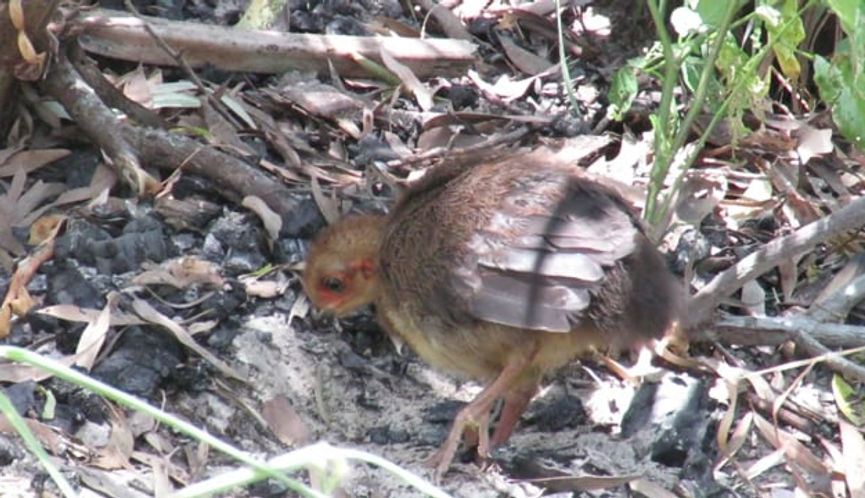Australian Brush-turkey
Alectura lathami
Quick facts
Other names: Scrub Turkey.
Size: Larger than Domestic Chicken.
Range and lifestyle: Eastern Australia, south to near Sydney.
Food: Seeds and soil-dwelling invertebrates.
Breeding: Mostly June to December. Nest is mound of soil and rotting leaves and roots, up to 5 m wide and 1.5 m high. No parental care, but male maintains mound for around 5 months each year.
Unlike most of the birds that have successfully adapted to living in the relatively new human-made urban environment, the Brush Turkey originally came from the rainforest. The vast majority of rainforest-dwelling bird species need to live in their shady, densely-vegetated environment, and simply can’t adapt to cities because of their openness and lack of insects or fruit trees. The Australian Brush Turkey is a member of a family of birds called Megapodes, a name which literally means “big foot” and refers to their large, strong legs and feet, adapted for raking the ground as they search for seeds, worms and other invertebrates to eat.
But what really makes this family unique and famous is the way its members breed. Brush Turkeys don’t look after their babies at all! Instead of sitting on their eggs to incubate them (keeping them warm) until they hatch, Brush Turkeys build large mounds of rotting vegetation and soil to act as incubators, so they are free to do other things. Moreover, instead of mum and dad, or just mum caring for the eggs, it is the male Turkey that does all the hard work! Once he has established a territory, a male will build a mound, sometimes two, by raking up leaves and soil into a heap almost every day for two or more weeks. If females like the finished mound, they will mate with the male, dig a hole and lay an egg in it, and repeat the process 2-3 days later. Most females visit two to four mounds. The number of eggs in each mound varies from 8 to 34, which may belong to two or three females. After the eggs are laid, it’s all up to the male. Every day he digs holes in the mound and inserts his bill to check that the temperature of the nest is right (around 33°C), then adds or removes material as necessary. He does this for about 5 months each year. After 7 weeks, the chick hatches from its egg, and starts digging upwards through the mound, eventually reaching the surface after 20 hours.The chicks have to fend for themselves, but they are fully feathered and amazingly, they are able to fly just a few hours after emerging.
While the rainforest floor, with its deep layer of rotting leaves and twigs, is the Brush Turkey’s natural feeding ground, the mulch used by people in suburban gardens is similar, so these birds often visit urban areas to forage. As a result, many people regard them as garden-destroying pests, while others simply solve the problem by covering their garden beds with chicken-wire. As many parts of Brisbane are now well-vegetated, resembling rainforest, the local “Turkey” population has spread and increased dramatically over the last few decades. Like the Australian White Ibis, they have learnt how to exploit new sources of food, such as the huge amount of food “wastes” discarded by people in parks and around cafes. If people are taught how to dispose of their food scraps responsibly and make their gardens “turkey-proof”, however, they can begin to appreciate this remarkable bird.
Text © Richard Noske 2019 CC BY-NC-SA
Audio
Photo gallery
Video gallery
References
HANZAB 7A; Richard Noske.

















